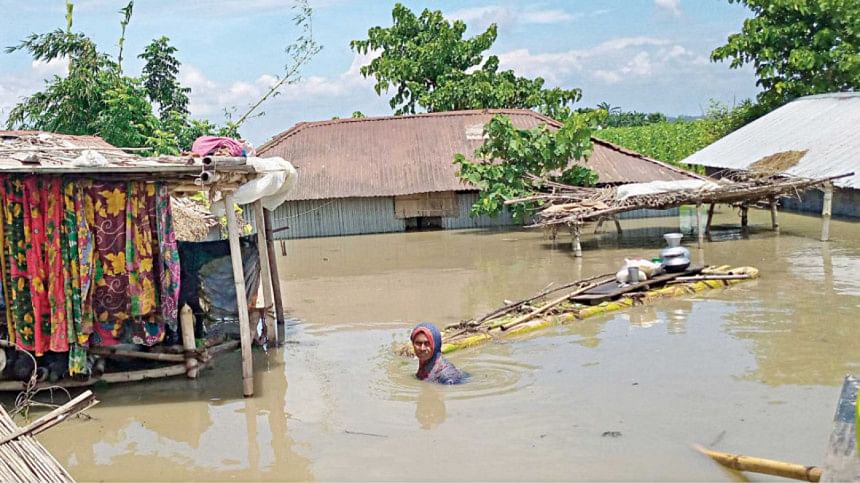In tackling climate change, we must aim for just resilience

Last month, Dhaka welcomed hundreds of delegates to the ninth edition of NAP Expo. The NAPs, or National Adaptation Plans, are the cornerstones of the mission to expedite adaptation. And this expo has been giving space to share experiences, views and progress across the world since 2013. But even after over a decade of negotiations through the UNFCCC process, the world has failed to produce a complete adaptation framework to track our adaptation actions.
In 2013, the African Group of Negotiators Experts Support (AGNES) proposed the Global Goal on Adaptation (GGA), which was established through the Paris Agreement at COP21 in 2015. The purpose of a universal adaptation framework was to speed up adaptation action and fund flow at the same level of mitigation. Sadly, the latest Adaptation Gap Report reveals that, while all the developing countries need $215-387 billion annually to support adaptation, 90-95 percent of this money has never been seen.
At COP28 (2023) in Dubai, a framework on the GGA called the UAE Framework for Global Climate Resilience was approved. This framework includes climate change impact, vulnerability and risk assessments, as well as national-level planning, implementation, monitoring, evaluation and learning mechanisms. But it is missing some important elements, such as measurable indicators to track adaptation actions and the progress towards global goals. Such global indicators are tricky since adaptation is context-specific. The team working on the GGA will now fill in such gaps and return to COP30 (2025) with a complete framework.
But, being the "adaptation capital of the world" and a pioneer in community-based adaptation, can Bangladesh show a path to set adaptation indicators?
Bangladesh's NAP (NAP2050) has a detailed monitoring and evaluation plan, listing 290 possible indicators (some are same or similar) against 28 outcomes of 23 strategic actions under six goals—very comprehensive indeed. Almost all of these indicators are relevant to the sector an outcome belongs to. For example, under the food and livelihood security goal (Goal 2), the outcome related to climate-smart agriculture (CSA) has indicators like number of organic farms and extent of the adoption of CSA practices. How effective these proposed indicators are in measuring adaptation action is yet to be tested. But are they good enough to measure equity and justice in adaptation action?
This question may seem academic, but it also has a deep, practical reason behind it. Climate change affects different groups of people differently—thus it creates further inequity in an already unjust society. So, when we build people's resilience against climate change, on the one hand, we need to reduce the unequal burden that climate change brings upon them. On the other hand, we should ensure equity in the distribution of adaptation benefits. These two aspects together define "just resilience," a concept that may also be called "leaving no one behind" in climate change discourse. In mitigation, we talk about "just transition" or "Just energy transition," where equity is ensured among people who would be affected during a shift from fossil fuel-driven economy to a renewable energy-driven one. While the Mujib Climate Prosperity Plan (MCPP) strongly envisages just transition by 2030, we don't explicitly bring in just resilience in our climate change conversations. But if we dig deeper into the 290 indicators of NAP2050, many talk about inclusive adaptation action by considering gender, age and disability segregated data, accessibility to infrastructure, poverty incidences, and social conflict resolution. Many other indicators focus on gender, youth, diverse gender identities, disability in agricultural practices, co-management initiatives, field demonstrations, and awareness-building of modern technologies. A few underscores resilient WASH facilities for urban poor, and women and youth-led entrepreneurship in adaptation.
We, however, need a thorough analysis of what just resilience should mean for Bangladesh. It can be done by identifying equity and justice in the Delta Plan 2100, Perspective Plan of Bangladesh 2020-2041, Climate Fiscal Framework, NAP2050, and MCPP. We then need to measure equity and justice in our resilience-building efforts by contextualising available adaptation protocols. One practical starting point would be the eight principles of Locally Led Adaptation (LLA). These principles can guide us on how equity could be mainstreamed into understanding climate change impact, identifying and prioritising collaborative adaptation action, inclusive decision-making, flexible project designing, financing those initiatives, and sustaining the same actions with transparency, accountability, local knowledge and capacity.
Through these immediate actions, Bangladesh can effectively contribute to the conversations of just resilience as the GGA framework gets finalised in the coming months.
Dr Haseeb Md Irfanullah is an independent consultant working on environment, climate change and research system, and a visiting research fellow at the University of Liberal Arts Bangladesh (ULAB). He can be reached at [email protected].
Views expressed in this article are the author's own.
Follow The Daily Star Opinion on Facebook for the latest opinions, commentaries and analyses by experts and professionals. To contribute your article or letter to The Daily Star Opinion, see our guidelines for submission.

 For all latest news, follow The Daily Star's Google News channel.
For all latest news, follow The Daily Star's Google News channel. 










Comments